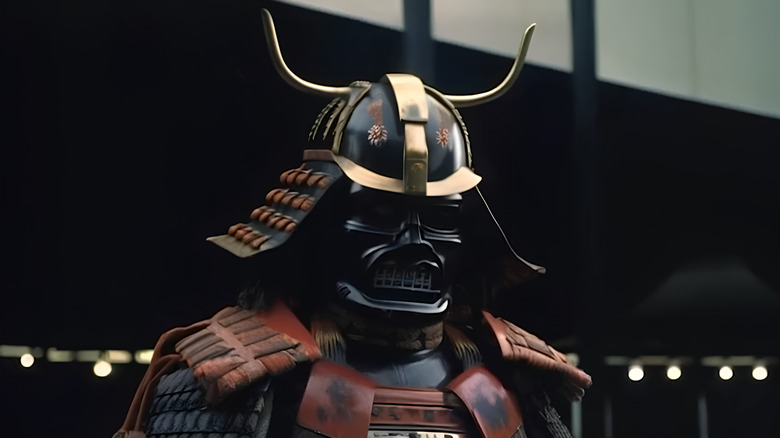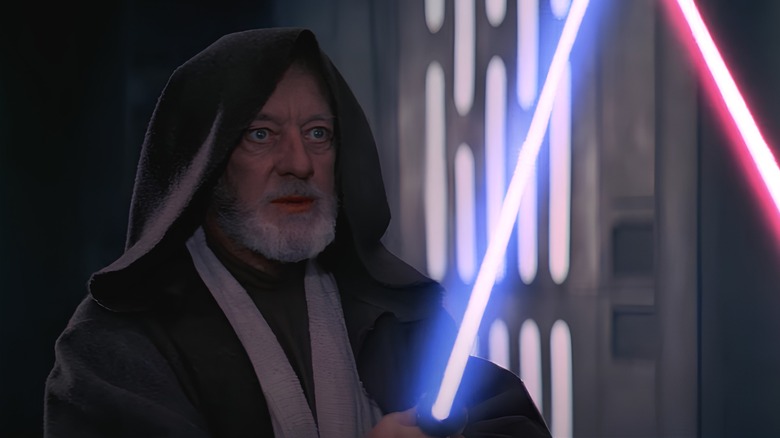Star Wars Reshot As A Japanese Gangster Movie Looks Unbelievable
For almost 50 years, "Star Wars" has remained an indelible force (zing!) in pop culture, with "Ahsoka," the tale of the powerful Ahsoka Tano, the most recent example of the show's staying power. That sustained interest is in part owing to the franchise's confluence of different genres, including sci-fi, space opera, and the humble western.
Now, one fan has reimagined "Star Wars" as a Japanese gangster film as part of a paid partnership with the generative AI platform D-ID. The TikTok is a greatest hits of "Star Wars" characters. Even transformed into Japanese "actors," the human characters, including Luke, Leia, and Han Solo, are distinct and recognizable. Luke's hair is as plush and feathery as it was in 1977, and Leia is decked out in her signature side buns. The characters dress in a combination of Western clothes and traditional Japanese garb that hews closely to their "Star Wars" costumes.
The more fun transformations, however, are the non-human characters who have been turned into humans. Jabba the Hutt is a tattooed man lounging in sunglasses and an open bathrobe, and he possesses the same slack-jawed stare. Yoda wears round sunglasses and olive green, with large (but not comically so) ears. Chewbacca's transformation is less successful, as evidenced by his strangely wispy, unkempt beard, but the updated Darth Maul is slick and menacing. A consummate villain in a John Wick-esque suit, his face makeup recalls yakuza tattoos. He's no match, however, for Darth Vader, who is outfitted in a traditional samurai get-up.
The video is a nod to Star Wars' Japanese influences
Turning "Star Wars" into a Japanese gangster film may seem like a whimsical crossover, but fans of "Star Wars" lore might be aware that the franchise is indebted to Japanese cinema. When he first conceived of "Star Wars," George Lucas borrowed from a number of films, including those of Akira Kurosawa, for inspiration. Kurosawa is best known for his films "Rashomon" and "Seven Samurai," but Lucas was especially compelled by his comparatively little-known 1958 film, "The Hidden Fortress."
"'Hidden Fortress'... did influence me in doing 'Star Wars' because I was beginning to write the screenplay and put it together," the director said in an interview with Criterion Collection. "The one thing that really struck me about 'Hidden Fortress'... was the fact that the story was told from the [perspective of the] two lowest characters." Lucas adopted this storytelling format, positioning R2-D2 and C-3PO as the points of entry. "In 'Star Wars” case, it is the two droids and that was the strongest influence actually." Like "Star Wars," "The Hidden Fortress" features an outspoken princess who is contending with an enemy force during wartime.
Other Japanese influences crop up elsewhere. The term Jedi comes from the Japanese word "jidaigeki," the period drama genre of which Kurosawa was a master. Moreover, Lucas outfitted Darth Vader and the stormtroopers based on samurai attire, with Vader, in particular, strongly resembling a feudal Japanese warlord in his Kabuto-like helmet. Demonflyingfox's TikTok is an overt celebration of Darth Vader's samurai roots.

